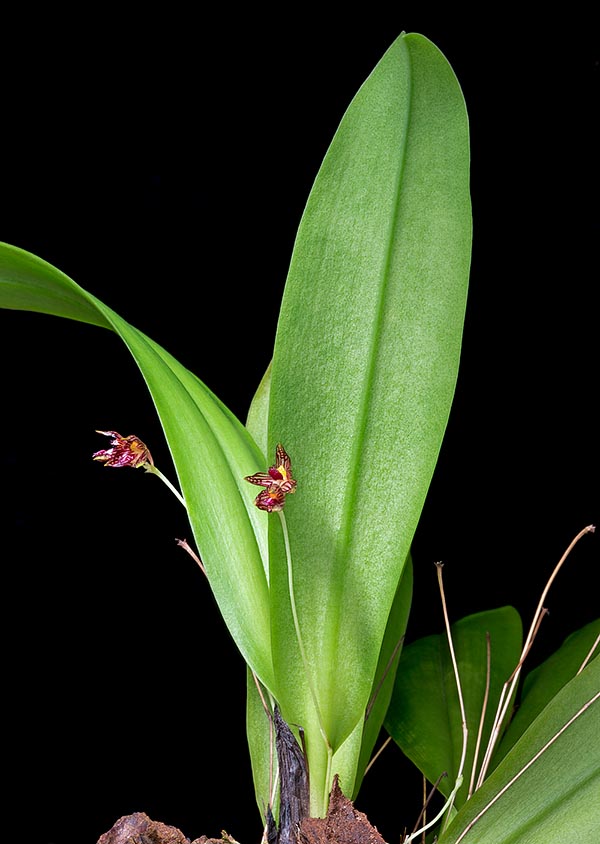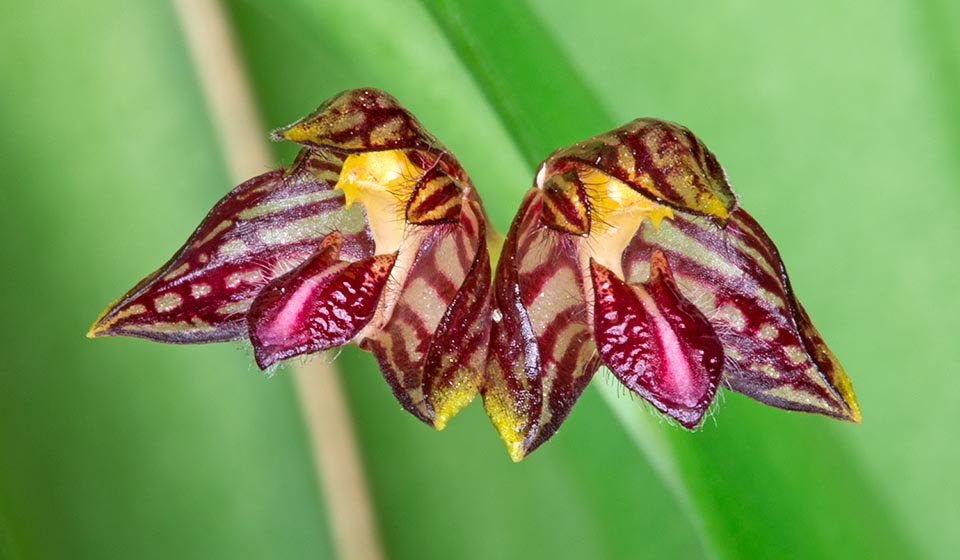Family : Orchidaceae

Text © Pietro Puccio

English translation by Mario Beltramini

South-East Asian epiphyte with creeping rhizome, the Bulbophyllum hirtulum forms compact tufts with close globose pseudobulbs, even 15 cm long leaves and thin 5-9 cm scapes © Giuseppe Mazza
The name of the genus is the combination of the Greek substantives “βολβός” (bolbos) = bulb and “φύλλον” (phyllon) = leaf, with reference to the leaves growing at the apex of the pseudobulbs; the specific name is the Latin adjective “hirtulus, a, um” = provided of short hairs, with reference to the hairs present at the margins of petals and labellum.
The Bulbophyllum hirtulum Ridl. (1900) is a rather variable epiphytic species with creeping rhizome, of 1-2,5 mm of diameter, and close globose pseudobulbs, 0,6-1,3 cm long and of 0,3-0,7 cm of diameter, provided at the apex of one single oblong-lanceolate leaf with obtuse apex, 3-15 cm long and 0,8-4 cm broad, of pale green colour, coriaceous.
Basal inflorescence, on a thin scape 5-9 cm long, bearing 1-14 tiny close flowers not completely open, of about 6 mm of diameter, with whitish or yellowish white sepals and petals with gridded veins of purple red colour and dark purple red labellum with paler central band; pedicel and 2-4 mm long ovary.
Ovate-triangular dorsal sepal with acute apex and ciliate margins, concave, 4-6 mm long and 2-3 mm broad, ovate-triangular lateral sepals with acute apex, 4-6 mm long and 3-5 mm broad. Oblong-linear petals with obtuse or acute apex and ciliate margins, 2-3 mm long and 1-2 mm broad, linguiform labellum with obtuse or acute apex and ciliate margins, 2,5-4 mm long and 1,5-3 mm broad, fleshy, and 1,5-2,5 mm long column.
It reproduces by seed, in vitro, and by division at the vegetative restart, with each section provided of at least 3-4 pseudobulbs.
Orchid with tiny flowers forming compact tufts, cultivable in pots as well as in baskets, with substratum formed by medium sliced bark fragments with possible addition of sphagnum and inerts, as well as on small trunks, rafts of cork or of roots of arborescent ferns with some sphagnum at the base.
It requires a partially shaded position, intermediate temperatures, high atmospheric humidity and constant ventilation. Frequent waterings and nebulizations during the growth of the pseudobulbs, slightly more spaced during the vegetative rest, allowing the substratum to partially dry up, utilizing rain water, demineralized or by reverse osmosis at ambient temperature.

The inflorescences have 1-14 tiny close flowers, not fully open, of about 6 mm of diameter with short hairs as the specific name states © Giuseppe Mazza
The species is reported on the appendix II of CITES (species whose trade is internationally ruled).
Synonyms: Bulbophyllum cincinnatum Ridl. (1903); Bulbophyllum trichoglottis Ridl. (1909); Bulbophyllum trichoglottis var. sumatranum J.J.Sm. (1920).
→ For general notions about ORCHIDACEAE please click here.
